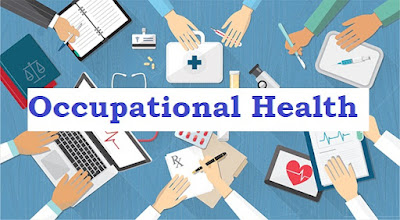Ensuring a Safe & Healthy Workplace:
The Importance of
Occupational Health
Occupational
health refers to the branch of medicine that is concerned with the
identification and management of health hazards in the workplace. It is a multidisciplinary
field that includes industrial hygiene, toxicology, epidemiology, and
ergonomics. The goal of occupational health is to ensure that workers are able
to perform their job duties in a safe and healthy environment.
One of the key components of occupational health is industrial hygiene, which involves identifying and evaluating potential health hazards in the workplace. This can include things like chemical exposure, noise levels, and ergonomic factors such as repetitive motion. Once hazards have been identified, steps can be taken to control or eliminate them, such as providing personal protective equipment or redesigning the work process.
Another important aspect of occupational health is toxicology, which is the study of the effects of chemicals on human health. This can include things like evaluating the toxicity of new chemicals before they are used in the workplace, or monitoring the exposure of workers to known toxins. Occupational health professionals also work to ensure that workers are protected from exposure to hazardous materials, such as through the use of protective equipment and regulations.
Epidemiology
is also an important part of occupational health, as it allows for the study of
the health effects of specific industries or occupations. This can include
tracking the incidence of certain diseases or conditions among workers in a
particular industry, or identifying risk factors for certain health problems.
This information can then be used to develop interventions or policies to improve
the health and safety of workers in that industry.
Ergonomics is the study of how people interact with their environment, including the design of tools, equipment, and work spaces. Poor ergonomic design can lead to injuries and musculoskeletal disorders such as carpal tunnel syndrome and lower back pain. Occupational health professionals work to design work spaces and equipment that are safe and comfortable for workers, and to educate workers on how to use equipment safely.
Occupational health is a crucial field that helps to ensure that workers are able to perform their job duties in a safe and healthy environment. This can include identifying and controlling health hazards, protecting workers from exposure to hazardous materials, and promoting good ergonomic design.
In addition
to the areas of industrial hygiene, toxicology, epidemiology, and ergonomics,
there are a number of other important components of occupational health.
One of these is workplace safety, which encompasses a wide range of measures and practices aimed at preventing injuries and accidents on the job. This can include things like providing safety training, implementing safety procedures, and ensuring that workers have access to the proper equipment and personal protective gear.
Another important area of occupational health is the management of workplace stress, which can have a significant impact on worker health and productivity. This can include identifying the sources of stress in the workplace, such as heavy workloads or poor management, and implementing strategies to mitigate these stressors.
Occupational
health professionals also play a key role in the management and treatment of
work-related injuries and illnesses. This can include providing medical care
for injured workers, overseeing their recovery and rehabilitation, and working
with employers and insurers to ensure that workers are able to return to work
safely and as soon as possible.
Prevention is also a major focus of occupational health. This can include promoting healthy behaviors among workers, such as encouraging regular exercise and healthy eating, as well as implementing wellness programs aimed at reducing the risk of chronic diseases.
Another important area of occupational health is the protection of workers' rights and ensuring that employers are providing a fair and safe work environment. This can include ensuring compliance with workplace safety regulations, protecting workers from discrimination and harassment, and ensuring that workers are paid fairly and receive the appropriate benefits.
In summary,
occupational health is a multifaceted field that encompasses a wide range of
issues and practices aimed at promoting the health and safety of workers in the
workplace. This includes identifying and controlling health hazards, protecting
workers from exposure to hazardous materials, promoting good ergonomic design,
managing workplace stress, providing medical care for injured workers,
preventing injuries and illnesses, protecting workers' rights, and promoting
healthy behaviors among workers.
"Promoting
Occupational Health: Identifying and Managing Health Hazards in the
Workplace"
"Ensuring
a Safe and Healthy Workplace: The Importance of Occupational Health"
"Occupational
Health 101: Understanding and Managing Health Risks in the Workplace"
"Workplace
Wellness: The Role of Occupational Health in Promoting Employee Health and
Safety"
"Preventing
Workplace Injuries and Illnesses: The Significance of Occupational Health"
"Occupational
Health and Safety: Protecting Workers in the Modern Workplace"
"Navigating
Occupational Health: Strategies for Identifying and Managing Health Hazards in the
Workplace"
"The
Importance of Occupational Health for Employee Well-being and Safety"
"Occupational Health: A Multidisciplinary Approach to Improving Worker Health and Safety"
Occupational
health, workplace safety, industrial hygiene, toxicology, epidemiology,
ergonomics, workplace stress management, work-related injuries and illnesses,
prevention, workers' rights, healthy behaviors in the workplace, hazards,
chemical exposure, noise levels, personal protective equipment, ergonomic
design, musculoskeletal disorders, carpal tunnel syndrome, lower back pain.

No comments:
Post a Comment